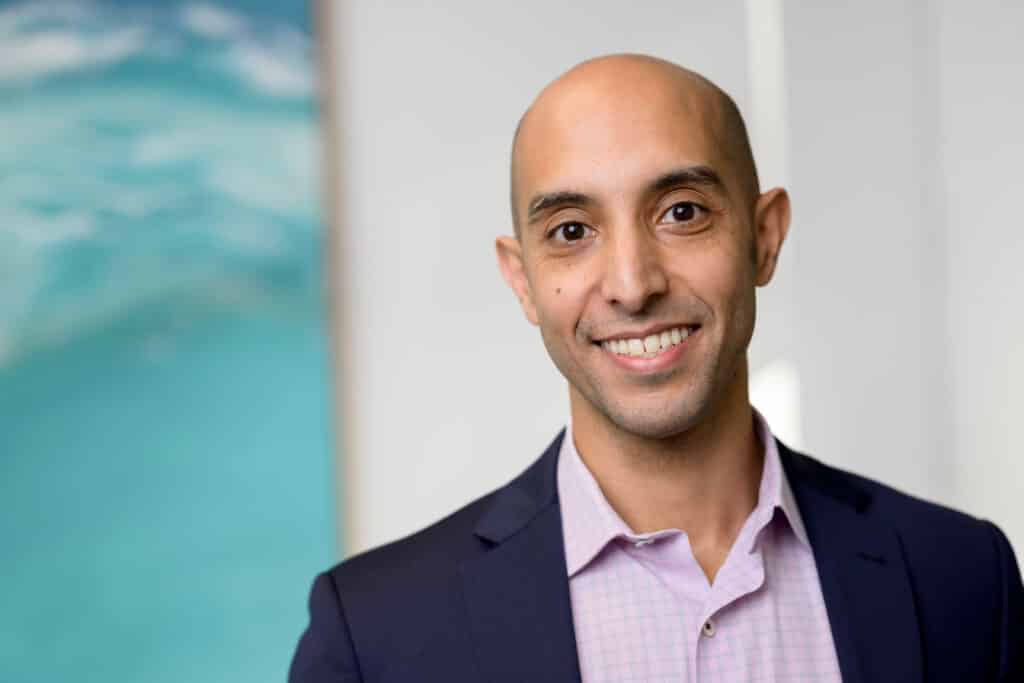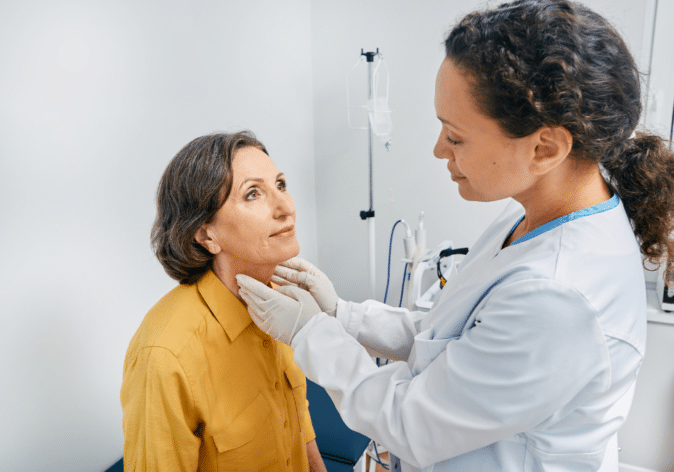As part of Breast Cancer Trials Clinical fellowship program, Dr Adam Ofri is working on two research projects focusing on de-escalation of treatment. His first study called the ‘Targeted Axillary Dissection Registry” will ascertain the safety and efficacy of targeted axillary dissection surgery (TAD), as an alternative to conventional axillary dissection, in patients who undergo neoadjuvant chemotherapy, which may produce less side effects.
His second study called the ‘The Australasian DCISionRT RCT’, aims to identify patients with DCIS who may be able to avoid unnecessary radiotherapy and the potential side effects.
Why is de-escalation of treatment such an important theme in breast cancer research?
“De-escalation in breast cancer has come about from our understanding of breast cancer pathophysiology. It used to be big operations with removal of the entire breast and cleaning out the armpit with the axillary dissections.”
“And over time we’ve realized that we can do less operating, less invasive procedures, but still maintain excellent outcomes for patients. And for me, the ability to offer the patient less invasive procedures means that they can have a better quality of life, and they have a lower risk of side effects, whilst knowing that I’m still providing them best care.”
Listen to the Podcast
Listen to our conversation with Dr Adam Ofri as he discusses his two research projects as part of the 2023 Breast Cancer Trials Clinical Fellowship Program.
Where does Australia sit in de-escalation of breast cancer treatment?
“I think Australia’s leading the way. They’re very eager to ensure that patients get tailored care. And a lot of the studies that are being conducted are to encourage best practice for patients. I think Australia’s had a good uptake with the targeted axillary dissection that has only really come out in the last 10 years. They’ve really been on board with trying to ensure that we can provide best practice without being excessive and really deescalating when appropriate.”
It’s a bit counterintuitive for a surgeon to say ‘we want to do less surgery’ and discussing radiotherapy, isn’t it? But throughout surgical training, you really learn about how to operate and when to operate. And when you get more senior, you start to learn about when not to operate, and that includes de-escalation, when to choose a less invasive operation – when you understand what the outcomes are, when you can appreciate if it’s going to have any impact on recurrence or disease-free survival or overall survival.”
“So, for me as a surgeon being able to tell a patient I don’t have to do something invasive, I can reduce your risk of a side effect or a sequalae, if you will, from a procedure, that makes me happy because less can be more, and I think that’s really true in surgery.”
What is Targeted Axillary Dissection?
“So Targeted Axillary Dissection is something that has been discussed in the last few years. For select breast cancer patients when they present, they’ll have a cancer in their breast, but they may also have it spread to their arm pit nodes.”
“Now, these type of patients in select cases could benefit from chemotherapy before surgery. Now with that change of practice, what we found is that we can in select cases, do less surgery in the armpit. So, if someone had turned up a decade or two ago with one or two nodes in their armpit, they would get what’s called an axillary clearance, which is to take away at least 10 nodes in the armpit.”
“This has risks associated with it. There are nerves, there’s vessels in the area, but also there’s a risk of developing lymphoedema, swelling in the arm. And that goes up to around 20-25% of cases. Now, a targeted auxiliary dissection is a way to evaluate the armpit nodes after chemotherapy and take away less nodes while still providing the same control of cancer in the armpit.”
“So, what it really is, is a targeted axillary dissection. And by evaluating how Australians are implementing this, how we are performing it, and how we manage the outcomes from it, I think we’ll be able to get data that’s more homogeneous rather than being all varied and subsequently allow us to evaluate it better.”
“And only with that strong, appropriate information can we then interpret it to figure out what we can now do beyond the TAD, and can we use the TAD and its results to do even less in the armpit without impacting patient outcomes.”
What methodology will this study use?
“So this study is really a registry and establishing the first registry in Australia where we capture high quality data about when people are choosing to do a TAD, how they do a TAD, and how they are managing the axilla after a TAD. The literature currently is a little bit varied with when people will do a TAD, how they do it and how they interpret it afterwards, which means that it’s really hard for us to know what’s best practice.”
“So, to be able to come up with what is best practice, we need to know what the practice is now, and we need to standardize what we’re doing if we want to evaluate it. And I think that’s one of the key limits that we currently have with determining where to go from here with a TAD because we don’t even have that appropriate data.”
“Some centres around the world are looking at how to de-escalate surgery, how to de-escalate management of the axilla after a TAD, and we just don’t know in Australia how we’re doing that currently.”
“So, by setting ourselves up to have a registry to collect the data properly, we can then evaluate that data, get a snapshot of what we’re doing, and from there we can build studies to evaluate TAD appropriately because we do a lot of surgery and we have a lot of breast cancer in Australia, unfortunately.”
“My hope is that by understanding how we do a TAD across Australia and discussing when we do it and how we manage it afterwards, we’ll be able to determine what may be better ways of doing it, whether we’ll be able to develop an Australian guideline or a recommendation regarding indications for a TAD, how to perform a TAD and subsequently what are the options of management after a TAD.”
What is your project ‘DCISionRT’ focusing on?
“DCISionRT is a really interesting test that’s been developed where you take breast tissue from patients who have had DCIS (that is pre-cancer) and you test it to see how much benefit they would receive from radiotherapy, and it can quantify how high your chance of it coming back is. Because DCIS can come back again as DCIS, pre-cancer, but in 50% of the time when it comes back, it comes back as cancer.”
“So we need to determine should we give radiotherapy to all patients or are there some patients that may benefit in avoiding radiotherapy. And the reason it would be good to avoid radiotherapy if you can safely, is if unfortunately you get a recurrence you’ll be able to have what we call breast conservation therapy where we just cut out the cancer. We keep the majority of the breast, and we can give you radiotherapy.”
“If we’ve burned our bridge and used radiotherapy for a small DCIS, then if a patient develops breast cancer down the line, they’ll have to get a mastectomy. Because you can’t get radiotherapy twice to the breast. So, my thoughts are by appropriately using DCISionRT, we can potentially avoid patients getting unnecessary radiotherapy, avoiding the side effects of radiotherapy and the impact on quality of life.
“And also on the other end, it can encourage us to give radiotherapy for some patients and motivate patients to have radiotherapy if they’ve got a more aggressive DCIS subtype. And some patients are scared of radiotherapy, and they don’t appreciate the benefit of it and being able to give them a number and say, this is how high your chances of getting a cancer or pre-cancer in the future can really help patients make an informed decision.”
What side effects can be associated with radiotherapy?
“So as a breast surgeon, we always have a little bit of an interesting discussion with our radiation oncologists, and we appreciate exactly what they do and the benefits. But from a breast surgeon point of view, radiotherapy can sometimes impact wound healing and it can change the appearance and the feel of the breast.”
“And sometimes if we’ve done a mastectomy and we’ve put in an implant, the radiotherapy can cause changing and scarring, which may need a patient to have another operation down the line to change things. So, radiotherapy is important because it reduces the risk of recurrence, but it can have those side effects.”
“It can also cause things down the line, albeit rarely because our radiation oncologists are very, very smart regarding how they’re doing their calculations and the delivery. But there are low chances of things like heart problems, lung problems and very rarely things like cancers forming.”
“So radiotherapy as great as it is, if we can de-escalate or avoid it, much like with axillary surgery, if we can provide tailored management to the patient and only give them the things that will benefit them, I think that everyone would agree that would be best practice.”
“My hope is if we can adequately perform a DCISionRT randomized control trial, and we show the benefits of it, I think this can impact every single person who has been diagnosed with DCIS. One in seven women are diagnosed by the age of 80 with a breast cancer, be it pre-cancer or invasive. And DCIS is more prevalent than invasive because we’re picking pre-cancerous up early. I think that this could have a great impact throughout all Australian and New Zealand patients.”
Is radiotherapy still the best standard of care?
“So that’s a good question, and that’s where I always explain to my patients, the evidence currently is if you have a lumpectomy that is only equal to having the breast off, also known as having a mastectomy, if you have radiotherapy, and that’s the standard line that I say.”
“In select situations, they may be able to avoid radiotherapy, in DCIS, and that’s where DCISionRT comes in.”
“Radiotherapy has been a game changer for breast cancer and it has allowed us to spare patients from losing their breasts. This has a significant improvement in the quality of life for patients, their mental health and also their sexual health as well.”
“By retaining as much of their own breast tissue, it can have so many good implications for patients, and we can only really do that with radiotherapy. So, to my patients, I always say it’s a highly advanced subspecialty, and radiation oncologists are researching consistently about how to employ the best radiotherapy techniques and modalities. I’d say to patients, it is one of the greatest advancements we’ve had in breast cancer.”
Dr. Adam Ofri’s Hopes for the Future
“All the research that we’ve done is always based off previous research. We’ve only moved to this place in breast cancer management and tailored and specialized breast cancer management because of all the hard work that other people have done. And it’s been through the tireless efforts of other researchers and academics that has led us to have the types of outcomes for breast cancer that we have.”
“The survivability is phenomenal in breast cancer, and that’s because of all the great advancements we’ve had. I would hope that by providing quality research, I can help advance our level of knowledge of breast cancer and breast cancer management, and continue to help increase that rate of survivability, and have breast cancer be an unfortunate event, but not something that scares people anymore.”
Support Us
Help us to change lives through breast cancer clinical trials research



